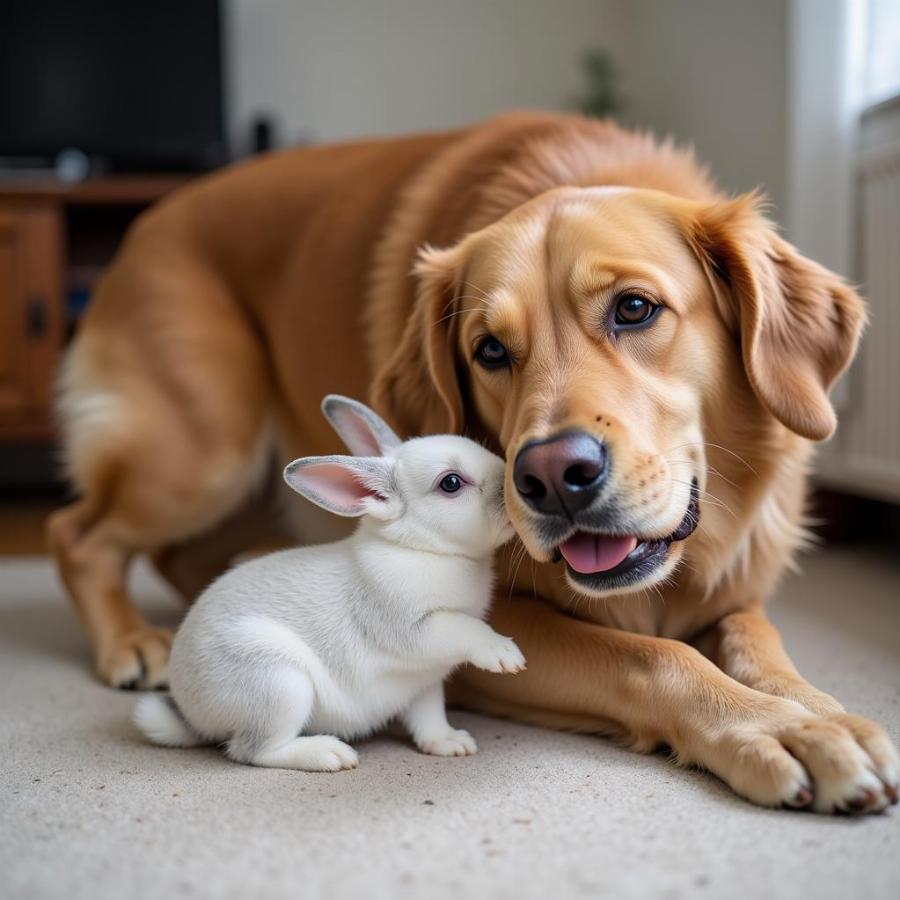Dogs and rabbits can coexist peacefully, but it takes careful introduction, supervision, and an understanding of their differing needs. While some dogs have a natural prey drive that could pose a threat to rabbits, many dogs can learn to accept a rabbit as a part of the family. The key to success lies in a gradual introduction process, proper training, and a safe, comfortable environment for both animals.  Chó và thỏ cùng chơi đùa trong nhà
Chó và thỏ cùng chơi đùa trong nhà
Understanding the Challenges: Prey Drive vs. Companionship
The biggest hurdle to overcome when introducing dogs and rabbits is the dog’s natural prey drive. Dogs are predators, and rabbits are prey animals. This instinct can trigger chasing, barking, and even aggression in some dogs. However, this doesn’t mean that dogs and rabbits are inherently incompatible. Many dogs can be trained to overcome their prey drive and live harmoniously with rabbits. It’s crucial to assess your dog’s temperament and behavior before attempting an introduction. A dog with a high prey drive, particularly one who has chased or harmed small animals in the past, might not be a suitable candidate for living with a rabbit.
Introducing Dogs and Rabbits: A Step-by-Step Guide
A gradual, controlled introduction is essential for a successful dog-rabbit relationship.
- Separate Spaces: Initially, keep the dog and rabbit in separate areas of the house. Allow them to get accustomed to each other’s scent without direct contact. Swap their bedding or toys to familiarize them with each other’s smells.
- Visual Contact: After a few days, allow brief, supervised visual contact through a barrier, such as a baby gate or a crate. Observe your dog’s behavior closely. If they show signs of aggression or excessive excitement, separate them immediately and try again later.
- Short, Supervised Interactions: Once both animals seem comfortable with visual contact, allow short, supervised interactions in a neutral space. Keep your dog on a leash and allow the rabbit to explore freely. Reward calm behavior with treats and praise.
- Gradual Increase in Interaction Time: Gradually increase the length and frequency of interactions as both animals become more comfortable. Always supervise these meetings, and be prepared to separate them if necessary.
- Unsupervised Interaction (with caution): Eventually, you may be able to allow unsupervised interactions, but this should only be done when you are absolutely confident that both animals are safe and comfortable with each other. Even then, it’s best to continue providing separate spaces for them to retreat to when they need some alone time.
Creating a Safe Environment for Both Pets
Providing a safe and comfortable environment for both your dog and rabbit is vital for their well-being and coexistence.
- Safe Space for the Rabbit: Ensure your rabbit has a secure enclosure where they can retreat and feel safe. This should be a dog-free zone where the rabbit can relax and escape if they feel threatened.
- Exercise and Enrichment: Both dogs and rabbits need plenty of exercise and enrichment to prevent boredom and frustration. A bored or frustrated dog is more likely to act out, potentially putting the rabbit at risk.
- Training Your Dog: Basic obedience training is essential for managing your dog’s behavior around the rabbit. Commands like “leave it” and “stay” can be invaluable in preventing unwanted interactions.
Can a Dog and a Rabbit Be Friends?
While the relationship between a dog and a rabbit might not always be a typical “friendship,” they can certainly learn to tolerate and even enjoy each other’s company. With patience, understanding, and proper management, you can create a peaceful and enriching environment for both your furry companions.
Conclusion
Successfully introducing a dog and a rabbit requires patience, careful planning, and consistent management. While the natural instincts of each animal can present challenges, with the right approach, they can coexist peacefully and even develop a positive relationship. Remember to prioritize the safety and well-being of both animals, and always supervise their interactions, especially in the early stages. By following these guidelines, you can increase the chances of a successful and harmonious multi-species household.
FAQ
- What dog breeds are best with rabbits? Breeds with lower prey drives, like Cavalier King Charles Spaniels or Golden Retrievers, are often considered more suitable. However, every dog is an individual, and temperament can vary within breeds.
- Can I leave my dog and rabbit alone together unsupervised? Initially, never leave them unsupervised. Even after a successful introduction, provide separate spaces and consider supervised interactions the norm.
- What should I do if my dog chases my rabbit? Immediately separate them. Re-evaluate your introduction process and consult with a professional dog trainer or animal behaviorist.
- How do I know if my rabbit is stressed? Signs of stress in rabbits include hiding, thumping their hind legs, changes in appetite, and aggressive behavior.
- Can a rabbit hurt a dog? While less common, a rabbit can scratch or bite a dog if they feel threatened.
Further Reading
For more information about dog care and training, check out our articles on hot dog weiners and what would dogs eat in the wild. If you are concerned about other potential dangers for your small dog, you might want to read about will a hawk attack a small dog. And for general dog care tips, check out why do dogs smell after being outside. Finally, if you’re just here for the cute animals, be sure to visit our cute husky dog page!